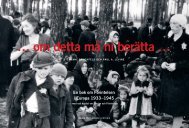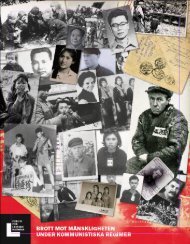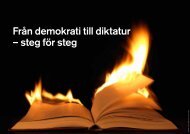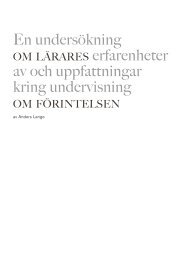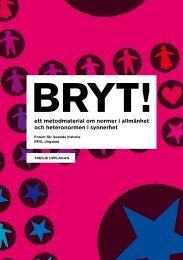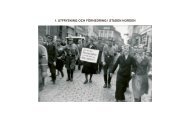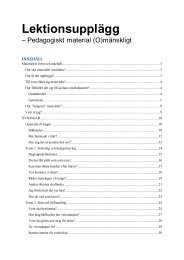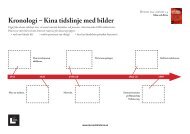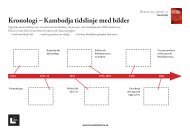Children…
Tell Ye Your Children... - Levandehistoria.se
Tell Ye Your Children... - Levandehistoria.se
- No tags were found...
You also want an ePaper? Increase the reach of your titles
YUMPU automatically turns print PDFs into web optimized ePapers that Google loves.
foreword<br />
This book,“Tell Ye Your <strong>Children…</strong>” was first published<br />
in 1998 as part of the “Living History” information campaign<br />
initiated by then Swedish Prime Minister Göran<br />
Persson. Over a decade later, the now permanent Living<br />
History Forum commissioned us to revise and update<br />
the book, which included complementing it with a<br />
newly written chapter on Sweden and the Holocaust.<br />
This has enabled us to include some of the findings of<br />
the extensive research conducted over the past decade,<br />
particularly when writing the new chapter on Sweden.<br />
We are grateful for this opportunity to publish<br />
an expanded edition in English. Many questions still<br />
remain, but there is a clearer picture today of how Sweden<br />
and its population reacted to first the persecution<br />
of Germany’s Jews and the subsequent deportation and<br />
murder of them throughout Europe between 1941 and<br />
1945. There was, in fact, no unified Swedish response.<br />
On the contrary, the Government and its citizens displayed<br />
a wide range of reactions.<br />
Despite massive research conducted into what is<br />
commonly known as the Holocaust, there remains much<br />
information missing. The order of events has, however,<br />
long been clear. The “Final Solution of the Jewish question”<br />
was characterised by its total,systematic and global<br />
nature. The road to the death camps and the countless<br />
scenes of murder in Europe went from old and new<br />
prejudices via hateful propaganda to the classification,<br />
discrimination and segregation of human beings. This<br />
was followed by the assembly, deportation and finally<br />
physical extermination by bullet, gas, starvation or disease.<br />
For Jews living in Central and Western Europe, this<br />
process could take several years. In other areas, it could<br />
be remarkably swift. For Jews in the Baltic States and<br />
the Soviet Union, it could be a matter of a few weeks –<br />
sometimes even one, single day.<br />
Even if we can never establish exactly how many<br />
people suffered from the Nazi vision of a “Germanic”<br />
empire in Europe under Greater Germany, the dimensions<br />
of the crime are clear enough. Simultaneous to<br />
approximately six million Jews being murdered in<br />
the Holocaust, over two hundred thousand “Gypsies”<br />
(Romani-speaking groups and Travellers) were subjected<br />
to genocidal policy. In Germany, tens of thousands<br />
of members of political resistors and “ordinary people”<br />
fell victim to the Nazis, along with well over one hundred<br />
thousand physically and mentally disabled people<br />
and “asocial elements”, thousands of homosexuals and<br />
Jehovah’s Witnesses. Close to ninety-eight per cent of<br />
victims lived outside Germany’s borders. Three million<br />
Soviet prisoners of war and as many, if not more,<br />
civilians in Poland, Belarus, Russia, Ukraine and the<br />
Baltic States also fell victim to the Nazi ideology of<br />
“race” and “Lebensraum” (living space).<br />
However, these figures come across as abstract and<br />
their real meaning is easily lost. Behind each number is a<br />
name, a face, a loved one; a future lost. Children, parents,<br />
relatives.That is why we begin with the story of the children<br />
of Bullenhuser Damm. During the war, the Nazis<br />
murdered close to one and a half million Jewish children.<br />
For every ten Jewish children alive in Europe when the<br />
war began, nine lost their lives. Why did this happen?<br />
We sought to describe historic events in a factual and<br />
sober manner, combining an enormous body of research<br />
with personal accounts.We hope this book will contribute<br />
to a greater awareness of the Holocaust, and act as<br />
a basis for a dialogue about morality, ethics and democracy<br />
– not only today but also in the future. Nonetheless,<br />
it can serve only as a starting point, and we urge all who<br />
are interested to continue their own search for knowledge<br />
and understanding.<br />
This book would have been impossible to write<br />
without the painstaking and persistent efforts of historians<br />
the world over to understand and explain different<br />
aspects of the Holocaust. We are greatly indebted to<br />
them. We also wish to take this opportunity to thank<br />
those who assisted us in revising and updating the book.<br />
We would particularly like to extend our warm thanks<br />
to our assistant Viktor Bernhardtz, photo editor Sanna<br />
Johansson and layout designer Magnus Wigg.We would<br />
also like to express our gratitude to Martin Månsson and<br />
Rune Rautio, who kindly supplied us with rare photos.<br />
Lars M. Andersson, Charlotta Brylla, Matthew Kott,<br />
Helmut Müssener, Ester Pollack, Mattias Tydén, Klas<br />
Åmark and Oscar Österberg shared their invaluable<br />
knowledge. Lastly, we wish to thank this edition’s project<br />
manager, Bitte Wallin, for her patience and support.<br />
Stockholm and Uppsala, August 2012<br />
Stéphane Bruchfeld and Paul A. Levine<br />
6



